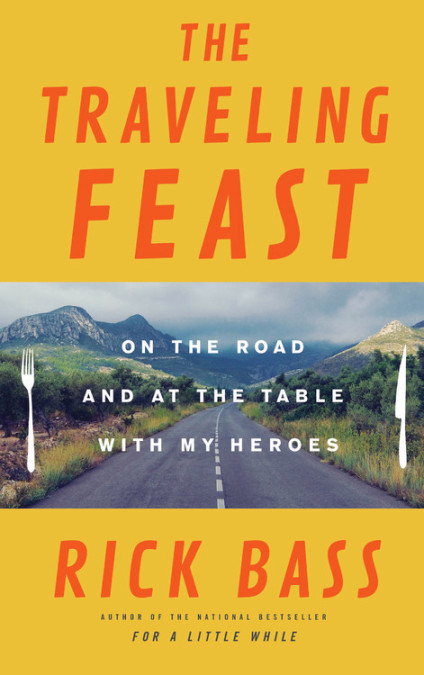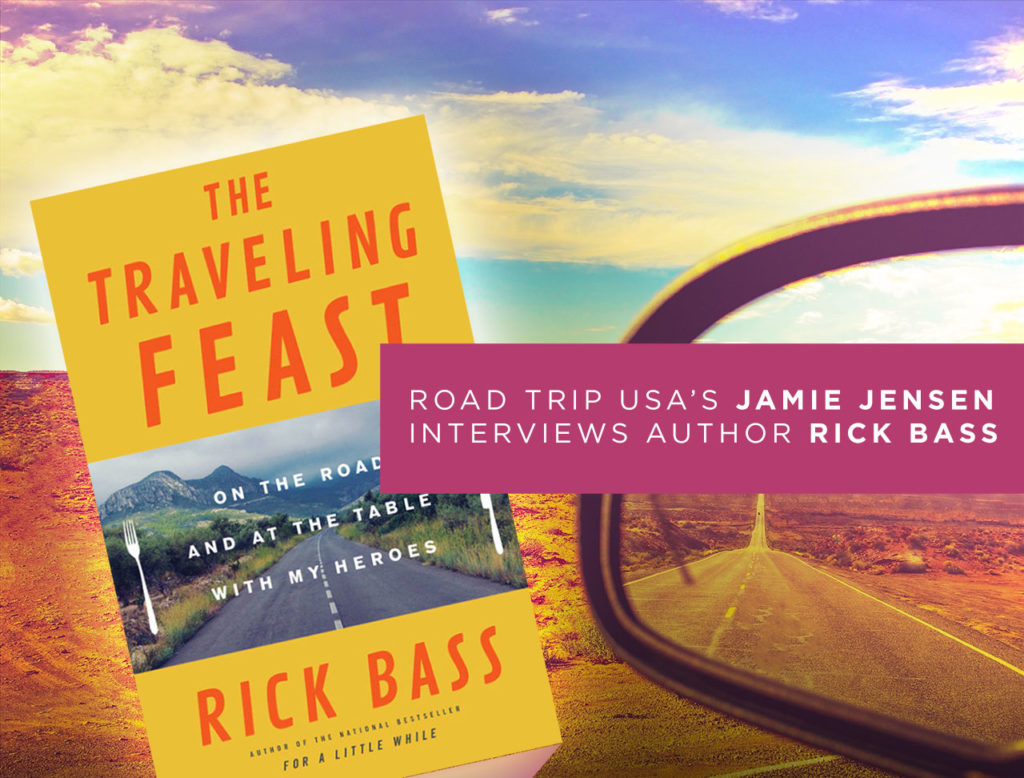In Conversation with Rick Bass, Author of The Traveling Feast

For Road Trip USA author Jamie Jensen and Rick Bass, author of The Traveling Feast, travel is an essential component of the creative process. Recently, the two discussed the importance of setting in literature, the joys of the open road, and how past experiences can shape our impression of new places. Their conversation follows:
Jamie Jensen: While the title of the book describes your encounters with “America’s Finest Writers,” reading the stories I came away with the sense that these trips were also visits to some of your closest friends. Visiting family and hanging out with friends are perhaps the best reasons for people to travel, and I wonder if you can talk about how the different destinations you were heading toward on these trips gave each one a distinctive feel. For instance, taking a trip to see Gary Snyder, who figures in Jack Kerouac’s classic road trip tales, would put me in a very different state-of-mind from say, driving through the English countryside to visit David Sedaris.
Rick Bass: Because for the most part we had to travel a long way to get to each writer, there was a lot to think about on the way there—but you’re right, as we drew nearer in the landscape of each other, we couldn’t help but to begin imagining a kind of gravity, an increasing density of place: restaurants where he or she had eaten, post offices he or she frequented, with the residue or perhaps sourcing of imagination falling across us, we imagined, like shadows.
JJ: Your book covers what seems like a lifetime of travel and road tripping experiences, and I wonder if there are particular moments or drives you remember most vividly. For me, for example, I will never forget a full moon drive across the Great Basin deserts of Nevada along two-lane US-50, “The Loneliest Road in America,” listening to a mix of Native American drumming and Jimi Hendrix hits from radio station KTNN 660 AM—the long-distance “Voice of the Navajo Nation.”
RB: The snowstorm in the Badlands, hailstorms and skies full of midsummer’s night lightning in eastern Montana, the wind in the tall grass at the McGuanes’ ranch, sitting in the spring sunlight outside Bovine Bakery in Point Reyes—there’s really no end to it! The project was definitely the experience of a lifetime.
JJ: In my experience, one thing that gets overlooked in writing about places is that each of us brings our own life experience with us wherever we go, shading new landscapes with memories of other places we have previously seen or lived in. Knowing a little of your life story, I would love to hear more about how, for example, having lived in West Texas and semi-tropical Mississippi influences your appreciation and understanding of Montana and the Rocky Mountains.
RB: Such a great question. It seems to me that I tend to see Southern stories as being constructed vertically, of time, whereas stories set in the West are often more spatially-oriented or structured—as if on a horizontal or planar axis. Time is often such a deeper element of so many Southern stories, whereas so many Western stories are constructed of space and distance. One of my favorite novels, Wallace Stegner’s Angle of Repose, is made from a wonderful convergence of the two elements.
JJ: Following on from that question of regional distinctiveness, I’d like to hear what you think about the “myth-making” machine that sometimes seems to power American writing, from William Faulkner in Mississippi to, say, Cormac McCarthy out west. How big a role does the geographical setting play for you when you are writing or telling a story? Which comes first: the story or the setting?
RB: Geography, setting, and sense of place are important to me as a naturalist—why is a species or population the way it is? And, certainly, as a storyteller: why does a person act the way he or she does, how do place and time shape a population and then a culture? That said, I can find no rhyme or reason as to why one story might have setting as its catalyst, and another character, and another sense-of-story, or any of the perhaps innumerable ways a story can take root. I do recall often, however, this amazing quote from Eudora Welty: “A place that ever was lived in is like a fire that never goes out. It flares up, it smolders for a time, it is fanned or smothered by circumstance, but its being is intact, forever fluttering within it, the result of some original ignition. Sometimes it gives out glory, sometimes its little light must be sought out to be seen, small and tender as a candle flame, but as certain.”
JJ: For me, in Road Trip USA, I take great pleasure in searching out the real-life locations of stories like John Steinbeck’s Cannery Row and East of Eden, or Sherwood Anderson’s Winesburg, Ohio. It is interesting to me how some writers go through a love-hate relationship with the places they write about. Steinbeck was almost literally run out of his home town of Salinas after writing Grapes of Wrath, for instance, but he is now a major part of the tourism industry there. Do you ever think twice about writing about real places, or do you sometimes disguise locations and change names to protect the innocent?
RB: Another great question. Yes, I consider a great deal what I might best phrase the “vulnerability” of a place in writing about it. This can be particularly tricky calculus when writing about small, imperiled places. Accurate threat assessment—and need—is important.
In fiction, best to play it safe, I think. As Wendell Berry suggests, one way to do this is to “Leave more tracks than necessary.” Embellish, misdirect, and above all, be interesting.
JJ: This touches on the great divide between fiction and nonfiction, which is a big subject! Is there really a line you can draw between the two? I’d be interested to hear if your stories ever start as nonfiction but turn into fiction, or vice versa. Do you ever get inspiration from overheard events that you later shape and craft into something dramatic, or would you see that as somehow betraying a confidence? As a travel writer, I struggle with ways to reconcile these very personal, individual stories with the more general, day-to-day “look and feel” of the towns and places I send my readers, so I’d be very interested to hear your thoughts!
RB: I do think there is a divide between fiction and nonfiction, and as with a mountain range, it can be broad or narrow and occasionally all but indistinguishable. I know that’s kind of a “maybe” answer. But that’s how I see it—as a wandering contour of separation, sometimes very thin, sometimes broad.
Almost always, I know before the first word—with the first word—whether a piece is going to be fiction or nonfiction. I get surprisingly little good fiction from overheard comments—I’m envious! Makes me wish I had better hearing!
As an activist who works on behalf of various endangered species such as grizzly bears—I’m currently involved with the Yaak Valley Forest Council’s efforts to protect the last 20 or so grizzlies in that valley from a hiking trail that would intentionally direct hundreds or thousands of hikers into the bears’ last protected habitat—I end up writing more nonfiction than I’d like.
The Traveling Feast: On the Road and at the Table with My Heroes (2018; Little, Brown) is available for purchase at your favorite bookseller.
About Rick Bass, author of The Traveling Feast
Rick Bass, the author of thirty books, won the Story Prize for his collection For a Little While and was a finalist for the National Book Critics Circle Award for his memoir Why I Came West. His work, which has appeared in The New Yorker, The Atlantic, Esquire, and The Paris Review, among many other publications, and has been anthologized numerous times in The Best American Short Stories, has also won multiple O. Henry Awards and Pushcart Prizes, as well as NEA and Guggenheim fellowships. Bass lives in Montana’s Yaak Valley, where he is a founding board member of the Yaak Valley Forest Council.
About Jamie Jensen, author of Road Trip USA
Jamie Jensen was immersed in road trip culture from an early age. He grew up in Southern California, back when freeways were new, cheeseburgers cost a quarter, and every beach had a beachfront amusement park. After a three-year stint bumming around the country, making hay in Kansas, and ghostwriting a book for the Grateful Dead, Jamie set to work researching and writing Road Trip USA. Since then he’s traveled more than 400,000 miles in search of the perfect stretch of two-lane blacktop. When not crisscrossing the country by car, he rides his bike whenever possible. Jamie lives with his wife, Catherine, and twin boys, Tom and Alex, in New York City, at the east end of the Lincoln Highway.













